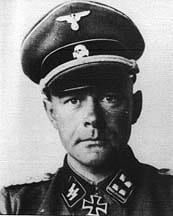17.SS-Panzergrenadier-Division “Götz von Berlichingen”
Emblem | ||
 | ||
Lineage | ||
| ||
History | ||
| October, 1943: Division raised in Southern France. 3 October, 1943: Honor title, “Götz von Berlichingen” bestowedby Reichsführer-SS Heinrich Himmler. 26 November, 1943: Werner Ostendorff promoted toSS-Brigadeführer and appointed division commanding officer asdivision continues to form in Tours, France. January, 1944: SS-Brigadeführer Ostendorff joins theDivision’s headquarters staff at Thouars, France. March, 1944: Division’s training nearly complete, and slated tojoin the 80. Armeekorps. 10 April, 1944: Reichsführer-SS Himmler travels from Berlin toattend the formal divisionactivation ceremony with “Sepp” Dietrich and General Leo Freiherr Geyr vonSchweppenburg at the town hall in Thouars. Cufftitles bestowed upon theDivision. 10 June, 1944: Division arrives in Normandy, France. 11/12 June, 1944: Into action at Carentan, defending thecrossroads between Saint Lo andCoutances. 12 June, 1944: Carentan falls to the US 101st Airborne Division asthe 17. SS moves intodefensive positions to the South. 13 June, 1944: Division unsuccessfully counterattacks atCoutances. 16 June, 1944: SS-Brigadeführer Ostendorff wounded andrelieved; SS-Oberführer Eduard Diesenhoffer appointed new Divisioncommanding officer. June, 1944: Defense of Saint Lo sector at Argentan. 6 August, 1944: Remnants of the Division temporarily assigned to 2.SS-Panzer Division “Das Reich”, kampfgruppe formedand attached to XLVII PanzerKorps, 7.Army. 6/7 August, 1944: 2. SS concentrated near Mortain, advancing onthe South side of the See Riveragainst the US 30th Infantry Division. 7 August, 1944: Counterattack at Mortain, Operation LUTTICH,against the US Third Army, fails. 28 August, 1944 Remnants of the 17. SS withdrawn from line combatto Chartres for restand refit. 1 September, 1944: Division in refit just West of Metz along theAbbeville-Mars-La-Tour Road,absorbs both SS-Panzergrenadier-Brigade 49 andthe SS-Panzergrenadier-Brigade 51, sent fromDenmark, and SS-Panzer Brigade “Merzig”(??). 5 September, 1944: Division sent 10 miles West of Arnaville. 7 September, 1944: 37.SS-Panzergrenadier-Regiment defends Dornotagainst the Second Battalion, 11th Infantry Regiment, US 5th InfantryDivision. 10 September, 1944: Arnaville Bridgehead established, First andSecond Battalions, 10th InfantryRegiment, US 5th Infantry Division, is attacked by the Division. Elementsof theDivision counterattack from Array towards Hill 386 (Bois Des Anneaux), andarerepulsed late in the afternoon. 11 September, 1944: SS-Panzergrenadier-Brigade 49 attacks the US4th Armored and 80th Infantry Divisions at Nancy. 12 September, 1944: Refit completed. At 0330, the Divisionre-commences the counterattack against the Arnaville Bridgehead. 13 September, 1944: Two battalions of the Division sent toreinforce the Dieulouard Bridgehead at Metz. 14 September, 1944: SS-Panzergrenadier-Brigade 49 in Foret DeFacq. 15 September, 1944: US 7th Armored Division ordered into theArnaville Bridgehead for the drive on Metz as the Division is reinforcedby elements of the 559. Volksgrenadier Division. German counterattackbegins and SS-Panzergrenadier-Brigade 49 moves South to face the US 80thInfantry Division. US 7th Armored and 5th Infantry Divisions fightthe Division to reach the Seille River. 17 September, 1944: Foret De Facq falls to the US 80th InfantryDivision. October, 1944: US 5th Infantry Division withdraws after failing totake Fort Driant. November, 1944: Division assigned to SS-Gruppenführer Max Simon’sXIII. SS-Korps and rebuilt. 17 November, 1944: 38.SS-Panzergrenadier Regiment evacuatesMetz. 19 November, 1944: Division relieves Kamfgruppe Mühlen at theMaginot Line near Faulquemont. 22 November, 1944: Metz falls to US Army. 30 November, 1944: German forces pushed back to the East bank ofthe Maderbach Creek. 31 December, 1944: Operation NORDWIND begins in theSaarbrücken-Saverne sector against the US First Army. 5 January, 1945: Operation NORDWIND fails. 15 March, 1945: Elements of the Division counterattack a battalionof the 7th Infantry Regiment, US 3rd Infantry Division at Uttweiler,supported by 9 assault guns., 7 of which are destroyed by a reliefbattalion of the 7th Infantry Regiment along with 4 WirbelwindFlakwagons. 17 March, 1945: Division southeast of Saarbrücken, East ofKaiserslautern, facing Lieutenant General Alexander Patch’s US SeventhArmy. Division in defense of Kaiserslautern, West of the Pfaelzer Forest,retreating along the East-West highway though the Forest and thesecondary road behind the West Wall. 22 March, 1945: Division still West of the Rhine, holding Landauand Neustadt. 25 March, 1945: Division across the Rhine, headed North of theNeckar River. 30 March, 1945: Division North of the Neckar in defense of theOdenwald. 1 April, 1945: Division skirmishes with the US 10th ArmoredDivision at the confluence of theJagst and Neckar Rivers. 3 April, 1945: Division moves along the Neckar River to North ofHeilbronn, still engaging theUS 10th Armored Division. 4 April, 1945: Counterattack against the 398th Armored InfantryRegiment, US 10th ArmoredDivision. 11 April, 1945: US 3rd and 45th Infantry Divisions occupy theHöhe Rhon Hills and begin the drive on Nuremburg. 13 April, 1945: Division moves into the gap between the US Firstand Seventh Armies,positioning for the defense of Nuremburg. 14 April, 1945: Last elements of the Division evacuate Heilbronn,and garrison Nuremburg,less one regiment. 16 April, 1945: Defense of Nuremburg begins. 21 April, 1945: Nuremburg falls and remnants of the Division moveSouth. 7 May, 1945: Division surrenders to US Army near Achensee,Bavaria. | ||
Organization | ||
| ||
Commanders | ||
 10.30.43 – 1.??.44 1.??.44 – ??.??.44 Gruppenführer Werner Ostendorff |
